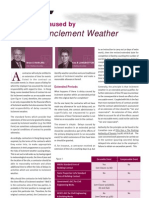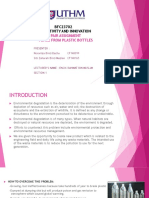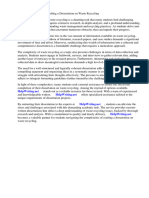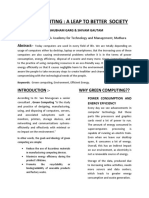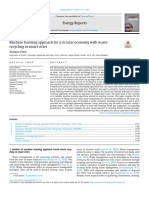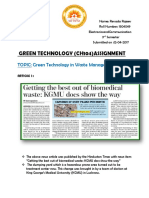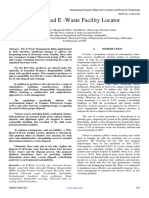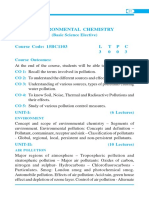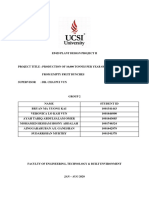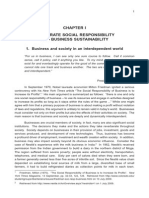Professional Documents
Culture Documents
Building Waste Management Innovation Based On Ecofriendly Incineration
Original Title
Copyright
Available Formats
Share this document
Did you find this document useful?
Is this content inappropriate?
Report this DocumentCopyright:
Available Formats
Building Waste Management Innovation Based On Ecofriendly Incineration
Copyright:
Available Formats
Volume 4, Issue 11, November – 2019 International Journal of Innovative Science and Research Technology
ISSN No:-2456-2165
Building Waste Management Innovation
Based on Ecofriendly Incineration
Bhakti Alamsyah 1 Wasilah2
1 2
Archirecture Egineering Architecture Engineering
Universitas Pembangunan Panca Budi Medan Universitas Islam Negeri Alauddin Makassar
Indonesia Indonesia
Abstract:- Waste is an unsolved problem that causes 3.962,63m3/per day was handled or only 95,37% of the
flood in Makassar. Based on the data taken by total generated waste. Those numbers needs to handle
Department of City Parks and Sanitation Makassar the especially for managing the waste integration in Makassar
generated waste reached 4.183.41/day in 2016, while as a whole.
only 3.962,63 m3/day or 95.37% was handled. Those
numbers need further action in a form of integrated Waste is always associated as left over things or
waste management. This research is to give ideas on worthless waste. Even human always produces waste, yet
innovation of building waste management that convert human himself is mostly avoiding the waste. So far, people
the waste into electricity energy or Waste to Energy by manage the waste with open dumping concept, burn, and
applying incineration technology. With Explorative sanitary land fill which are not good solutions. The main
approach, the aim of the research is to find out form cause of flood is organic waste, plastic or can that is not
and function of building that is suitable with generated degradable. These kinds of waste should get special
waste problem. The data collection is direct observation, attention for recycling. In this context, a solution for
documentation and interviewing related institution. The accurate city waste handling requires to minimize the
result of this research covers waste management at generated waste to reach zero waste. Waste and its
Integrated Final Disposal Site, Tamangapa, Makassar management is an urgent problem in Makassar as it can
designed as a building. The building will generate the change the ecosystem balance that will damage and pollute
waste and will not disturb the surrounding people who the water, soil and air. Therefore, to be able to solve the
live at the area. The building is expressive to change its pollution problem, we need to handle and control the waste.
negative impression of community towards the waste. The problem often occurs in managing the city waste is the
The design applied is to strengthen the image of waste operational fee that is high as well as a proper place for
management building that is innovative, effective and disposing the waste.
educative. The building is designed to be able to burn
the waste up to 700 tons/day using 2 units incineration Based on the fact, we need a breakthrough in
machine which can produce electricity output 10.000 processing the city waste. One of the solutions is to convert
KWH and the incinerator operational uses 50% of total the waste into electricity energy or Waste to Energy
electricity output. system. Waste-to-Energy System (WTE) burns city waste
non-B3 to produce electricity or steam, and sterilizing at
Keywords:- Flood, Building Inovation, Waste, Incineration, the same time also reducing the waste volume for landfill.
Waste to Energy. The implementation is by applying incineration technology
using the waste as the fuel.
I. INTRODUCTION (HEADING 1)
Incineration technology converts solid material (in
Makassar, the capital of South Sulawesi, is one of this context, waste) become gas material (exhaust gas), and
metropolis cities in Indonesia, has been developed rapidly solid material hard to burn, that is bottom ash and fly ash.
and played its role as the gate for Eastern Indonesia. One of This technology produces heat as the result of incineration
the impacts as developing city is the increasing of waste process that is useful for converting one material become
volume that demands more facilities on limited areas. another different material such as for electricity or hot
Based on the circumstances, it required to have a good and water. Incineration is a managing waste method by burning
efficient waste management. the waste over the stove. In some developed countries,
incineration technology has applied in big capacity (city
Waste is an endless problem that increases in terms of scale) (Damanhuri and padmi, 2008).
number and quality annually. The increase is along with
the growth of population in Makassar as well as the growth Incinerator technology in big scale is growing
of other industry sectors. In addition, there is also limitation continuously especially when there are many denials
of facilities and infrastructures, Final Disposal Site, and concerning air pollution. One of its strengths developing in
other facilities are effective and efficient in managing the the newest incinerator technology is the use of energy, so
waste. Based on the data Department of City Parks and the term incinerator will change to become waste-to-energy
Sanitation Makassar, the generated waste reached thermal converter.
4.183.41m3/day in 2016 in Makassar while only
IJISRT19NOV361 www.ijisrt.com 664
Volume 4, Issue 11, November – 2019 International Journal of Innovative Science and Research Technology
ISSN No:-2456-2165
data. The interview method is by using purposive sampling
method to collect supportive document for completing the
observation result.
B. Data Analyzing Method
Data Analyzing Method is design exploration. The
method is deciding ideal design implemented at the research
location in Final Disposal Site area in Makassar, Tamangapa
Sub district. The existing condition of Final Disposal Site
Tamangapa is accommodating a lot of generated waste that
become more and more in amount. This condition
Fig 1:- Incineration Process. influences the health condition and comfortable of the
Source: Damanhuri dan Padmi, 2008 people who live surrounding the site. Therefore, we need
technologies that solve the waste problem. By using this
Therefore, incineration technology became a strategic method, we can create ecofriendly incineration base waste
alternative in reducing the waste. The potential of waste management as one of the solutions for waste and electricity
reducing with incineration technology is very effective and problems for community in Makassar.
the important thing it can produce electricity. It will be very
helpful in reducing the burden of State Electricity Company The steps of conducting the research among others are:
in providing electricity for community.
Literature study, by data collection related to city waste
For this reason, the planning of incineration process, the application of incineration technology, also
technology implementation or waste-to-energy hopefully the need and room standard for waste management
can become a new breakthrough in solving waste problems facility.
and electricity consuming in city. In addition, the design of Observation of research location for collecting
building should be able to give solution in handling waste in information about economic potentials and physical
Makassar. environment of research location that can support the
success of building innovation design
II. METHODOLOGY Analyzing of design approach is analysis and simulation
on research location as well as analysis towards strategy
The research used qualitative method. Qualitative of shape application and building facility.
research methodology based on postpositivism philosophy Organization the concepts and design exploration on
that is used to investigate natural condition of the research waste management building by applying of incineration
object, where the researcher played a role as the key technology that integrated with the research
instrument, the sample taken purposively (Creswell, 2008). environment.
The category of this research character is explorative with Design result is a building of waste management by
inductive approach. Explorative research is a method to applying incineration technology that is environmentally
observe an object deeply. Therefore, this explorative friendly so it can minimize the waste problem and
research is finding things that influence something (Groat maximizing waste potential by producing energy.
and Waang, 2002). The approach used in this research is
inductive approach. The approach is drawing general III. RESULT AND DISCUSSION
conclusion from real facts at the place. Inductive is one
ways of thinking in which a general conclusion drawn from Based on the data of Department of City Parks and
various cases individually. The conclusion taken inductively Sanitation, the generated waste reached 4.183.41m3/day in
starts by putting the general statements together. In other 2016 in Makassar while only 3.962,63m3 /per day was
words, inductive approach is a research that starts or base on handled or only 95,37% of the total generated waste. It can
data or facts that then connected to the relevant or be seen that the waste volume input in Final Disposal Site
appropriate theories in order to get a general conclusion. Makassar is big enough. The number is too far from the
target of waste reducing that becomes one of the waste
A. Data Collection Method management methods, that is 20 % from the total of daily
The data collection is direct observation, waste output.
documentation and interview. Direct observation method is
getting the data directly to see the physical condition The prediction of generated waste either now or in the
without certain manipulation. The data collection related to future is the basis for planning, designing, and reviewing of
city waste management, implementation of incineration waste management system that is accurate and efficient.
technology and standard room needed for waste Incineration technology considered able to answer the
management facility. Documentation is at the research challenge of waste problem in Makassar. Incineration
location, Integrated Final Disposal Site Tamangapa that will technology is waste treatment process by burning solid
become the area of eco-friendly incineration base waste material in very high temperature (>800 degree Celsius) to
management building in Makassar. The documentations are reduce combustible waste, which cannot be recycled. The
photos and other form of data that need in analyzing the target of incineration is to reduce mass and volume of waste
IJISRT19NOV361 www.ijisrt.com 665
Volume 4, Issue 11, November – 2019 International Journal of Innovative Science and Research Technology
ISSN No:-2456-2165
as well as to kill bacteria and virus chemical material toxic, project autodesk software. So that, based on the
and to ease the process waste organizing. Incineration can consideration, the site form is referring to the area pattern
reduce the waste volume of domestic solid up to 85-95% that elongated from the north to the south to maximize wind
and mass reduction up to 70-80%. blowing and the path of the sun.
The incinerator machine for burning the waste should The design of the site is partial circulation system
complete with supervision and control to fulfill particle between facilities for waste processing and other activities.
emission limits to make sure the smoke of burning waste is It is for minimize the cross of activities to give a comfort for
neutral. In addition, the ash produced of waste burning can the building user. In main gate area, the circulation system
be useful for building material, compos mixture or thrown divided into two areas for public transportation and waste
on landfill. Meanwhile, the residue that is not combustible trucks.
such as metal can be recycled.
The building mass designed with integral combination,
A. Site Design start from main building in north, then connected with a
The location of plan building is in Final Disposal Site visitor center area along the waste elongated across the
area in Makassar Sub district Tamangapa. The landscape is waste process until the residue area in south. To create
inspired from the pattern observation of satellite image line ecology environment, green site plan implemented across
on planning site that later on become the patterns of building the whole site design. The aim is to form a green open area
site. Next, for consideration of building orientation, analysis that is comfortable for the building user.
of wind and the path of the sun practice by using Vasari
Fig 2:- Site Design of Ecofriendly Incineration Base Waste Process Building.
Source: Suradin, 2016
B. Form of Building mostly used glass material that is complete with green area
The process area of Integrated Final Disposal Site to reduce the sun heat wave.
Amangapa designed in a form of building that the generated
waste would not disturb the view, creating comfortable and
health of people who reside in the area. Building façade is
IJISRT19NOV361 www.ijisrt.com 666
Volume 4, Issue 11, November – 2019 International Journal of Innovative Science and Research Technology
ISSN No:-2456-2165
The form of the building is expressive to change dirty image. That is why the design need an application that
people negative image on waste. As the building of waste strengthens the image of waste process facility building that
process facility, the building form creation is referring to the is innovative, effective and educative.
environment-integrated process far away from slum and
Fig 3:- Waste Process Building Perspective
Fig 4:- Transformation of Ecofriendly Incineration Base Waste Process Building
Source: Suradin, 2016
The inspiration of the form comes from combination expressive image. Massa Building mass is designed with
of landscape pattern application and geometric integral combination system, start with the main building
transformation result in hill like building. The hill like in north then connected by center visitor area that is
form becomes the basis of recurrence pattern. For building elongated across the area of waste process to the residue
view on north façade, organic pattern used to create natural area in south.
IJISRT19NOV361 www.ijisrt.com 667
Volume 4, Issue 11, November – 2019 International Journal of Innovative Science and Research Technology
ISSN No:-2456-2165
Fig 5:- Building Mass Organization in Waste Process Site Incineration Base in Integrated Final Disposal Site in Amangapa.
Source: Suradin, 2016
C. The Concept of Waste Process tons. In other words, waste production process is 496 tons
Based on Zubair et.al. (2011), house hold generated with around 60% water content, next the reduction of
waste in Makassar was 2.18 ltr/person/day in volume or water content up to 50% done by bunker dewatering
0.28 kg/person with population of 1.796.920 in March system for 3-5 days. The temperature of burning with
2017 based on report published Population and Civil incinerator unit is 850 degree Celsius. If the temperature is
Registration Agency, so waste production daily was 496 too low, dioxin will not be formed.
Fig 6:- Units in Incinerator with City Scale
Source: Damanhuri and Padmi, 2008.
In incinerator technology there 4 process category, namely incineration results in, among others:
Pre-treatment process
Burning Process Incinerator Bottom Ash (IBA) is as big as 20-30% of
Recovery energy process waste mass. IBA is solid residue that is zero harm to be
Gas fuel handling process (APC system) thrown.
Based on the process mentioned above waste
IJISRT19NOV361 www.ijisrt.com 668
Volume 4, Issue 11, November – 2019 International Journal of Innovative Science and Research Technology
ISSN No:-2456-2165
Metal (iron or non-iron) as big as 2-5% of waste mass. Emission to atmosphere is in amount of 70-75% of
The metal is gained from the process of sorting out to waste mass. This emission results in cleaned gas.
the waste or IBA
Fig 7:- The Concept of Waste Process with Incineration Technology.
Source: Suradin, 2016
The building specification is designed to be able to So, the design application demands to strengthen
burn waste up to 700 tons per day using the incineration image of waste process building which is innovative,
machine with electric output of 10,000 KWH from 2 units, effective and educative. In addition, the specification of the
for incinerator operational 50% electricity output is needed. building is designed to be able to burn waste up to 700 tons
per day, using incineration machine with electricity output
IV. CONCLUSION 10.000 KWH of 2 machines, and for incinerator operational
50% electricity output is needed.
Waste process area in Integrated Final Disposal Area
Amangapa, Makassar designed in a form of building that The implementation of incineration technology used
generated waste does not disturb people living comfortable waste fuel is a strategic alternative in reducing generated
in the surrounding. The form of the building is expressive waste. The potential waste reduction with incineration
in order to change the negative image on waste. The technology is very effective and especially it can produce
creation of the building refers to the process of integrated electricity output. Other advantages of incineration
environment far away from slum and dirty image. technology, among others, are reducing 90% of generated
waste, energy recovery if it is well managed, air pollution
released is low, needs minimal area.
IJISRT19NOV361 www.ijisrt.com 669
Volume 4, Issue 11, November – 2019 International Journal of Innovative Science and Research Technology
ISSN No:-2456-2165
Even though this technology is able to reduce the Journal of Regional and City Planning 23, no. 3: 225–
waste volume until 70%, yet the incinerator is costly in 40.
terms of investment, operational and maintenance. The [13]. Puspa, Balebat Buana. 2017. “Kajian Konsep
facility of waste burn should use only for gutting/burning Pengelolaan Sampah Yang Terintegrasi Untuk
unrecyclable waste. The tool need to be completed with Mendukung Pengelolaan Sampah Yang Berkelanjutan
supervision and controlling system to fulfill the fulfill Di Kota Pekanbaru.” Fakultas Teknik Unpas.
emission limits to make sure that the smoke results from the [14]. Susuki, Willie Sine. 2016. “Analyzing Feasibility of
burning is neutral/cleaned gas. The ash from of burning can Waste to Energy Technologies Using Life Cycle
use for building material, compos mixture material or Assessment Method Based on Waste Stream
thrown away on landfill. Meanwhile the waste residue that Composition in Surakarta City.” Universitas Sebelas
not burned such as metal can be recycled. Maret.
[15]. Yuliani, Manis. 2016. “Incineration For Municipal
ACKNOWLEDGMENT Solid Waste Treatment,” Jurnal Rekayasa Lingkungan
9, no. 2.
Acknowledgments are addressed to all the great family [16]. Zubair, Achmad, Nogard S. Mahendra, Asrini. 2011.
of Architectural Engineering UIN Alauddin Makassar which Studi Karakteristik Sampah Rumah Tangga di Kota
provides a variety of support and contribution is not infinite. Madya Makassar dan Prospek Pengembangannya.
The author also expressed his gratitude towards the use of Dalam prosiding Hasil Penelitian Fakultas Teknik
facilities and equipment of Architecture Lab UIN Alauddin 2011. Universitas Hasanuddin Makassar.
Makassar which has helped complete the design. [17]. [UU] Undang-Undang Republik Indonesia Nomor 18
Tahun 2008 Tentang Pengelolaan Sampah.
REFERENCES [18]. [Permen] Peraturan Menteri Pekerjaan Umum
Republik Indonesia Nomor 29 Tahun 2006 Tentang
[1]. Balai Besar Teknologi Energi. 2012. Perencanaan Pedoman Persyaratan Teknis Bangunan Gedung.
Efisiensi dan Elastisitas Energi. Jakarta: Sekretariat [19]. [Permen] Peraturan Menteri Pekerjaan Umum
BPPT Press. Republik Indonesia Nomor 3 Tahun 2013 Tentang
[2]. Creswell, J.W. 2008. Research Design: Qualitative, Penyelenggaraan Prasarana Dan Sarana Persampahan
Quantitative, and Mixed Methods Approaches. Dalam Penanganan Sampah Rumah Tangga dan
California : Sage Publications, Inc. Sampah Sejenis Sampah Rumah Tangga.
[3]. Damanhuri, Enri dan Tri Padmi. 2008. Pengolahan
sampah. Diktat Kuliah Pengelolaan Sampah TL-3104.
Bandung : Program Studi Teknik Lingkungan FTSL
ITB.
[4]. Flinders, David. J, and Geoffrey E. Mill, eds. 1993.
Theory and Concepts in Qualitative Research :
Perspectives from the field. New York : Teachers
College Press.
[5]. Groat, L. and Wang, D. 2002. Architectural Research
Methods. New York : John Wiley & Sons. Inc.
[6]. Guzowski, M. 2010. Towards Zero Energy Building
Architecture New Solar Design. London : Laurence
King Publishing.
[7]. Kalmira, Hikmah, Satrio Nugroho, and Sri Hartuti
Wahyuningrum. 2015. “Waste To Energy Plant Di
Semarang.” Fakultas Teknik Universitas Diponegoro.
[8]. Kourik, R. 1997. The Lavender Garden : Beautiful
Varieties to Grow And Gather. Jakarta : Erlangga
[9]. Mediastika, C. E. 2013. Hemat Energi dan Lestari
Lingkungan Melalui Bangunan. Yogyakarta : Penerbit
ANDI.
[10]. Ni’mah, Nur Lailatun. 2016. "Pengelolaan Sampah
Kota Surabaya Tahun 1916-1940". Airlangga
University.
[11]. Nufus, Zakiyatun. 2015. “Lokasi Optimal
Intermediate Treatment Facilities Dan
Implementasinya Di Dki Jakarta,”
http://repository.ipb.ac.id/handle/123456789/80409.
[12]. Purwaningsih, Murni Rahayu. 2012. “Analisis Biaya
Manfaat Sosial Keberadaan Pembangkit Listrik
Tenaga Sampah Gedebage Bagi Masyarakat Sekitar,”
IJISRT19NOV361 www.ijisrt.com 670
You might also like
- Feb 03 Delay Caused by Inclement WeatherDocument2 pagesFeb 03 Delay Caused by Inclement WeatherbbwhaleNo ratings yet
- 3-Year PlanDocument31 pages3-Year PlannaxNo ratings yet
- Makati Shangri-La Hotel and Resort, Inc. vs. HarperDocument34 pagesMakati Shangri-La Hotel and Resort, Inc. vs. HarperoliveNo ratings yet
- DEMEROLDocument2 pagesDEMEROLDandel LagoyNo ratings yet
- Case presentationPHCDocument149 pagesCase presentationPHCChitPerRhosNo ratings yet
- Bot Law: RA 6957, Amended by RA 7718Document31 pagesBot Law: RA 6957, Amended by RA 7718boguz nonameNo ratings yet
- Aragones Final PaperDocument47 pagesAragones Final PaperNicolyn Augusthine AragonesNo ratings yet
- QuizDocument16 pagesQuizFareeha KhanNo ratings yet
- Re Visiting DivorceDocument19 pagesRe Visiting DivorceMai UgayNo ratings yet
- Pine Resin as Printer Ink BinderDocument11 pagesPine Resin as Printer Ink BinderNorries Jonell CaballarNo ratings yet
- Community Diagnosis FPT BibliographyDocument4 pagesCommunity Diagnosis FPT BibliographyKatherine 'Chingboo' Leonico LaudNo ratings yet
- Carrying Our Doctors OrderDocument52 pagesCarrying Our Doctors OrderMarie Kelsey Acena MacaraigNo ratings yet
- Create fences and construction materials from plastic bottlesDocument11 pagesCreate fences and construction materials from plastic bottlesthornyrosesNo ratings yet
- Smart Dustbin ReportDocument29 pagesSmart Dustbin ReportAkshay bypNo ratings yet
- Smart Garbage Collection1Document1 pageSmart Garbage Collection1Balaji B SurendranNo ratings yet
- Smart Garbage Collection2Document1 pageSmart Garbage Collection2Balaji B SurendranNo ratings yet
- J Me STN 42350375Document9 pagesJ Me STN 42350375Trần Hoàng BảoNo ratings yet
- Nayan Kohare-1Document14 pagesNayan Kohare-1Dnyaneshwar PrathameshNo ratings yet
- Peerj 8113Document19 pagesPeerj 8113Ananda LagoNo ratings yet
- Dissertation On Waste RecyclingDocument5 pagesDissertation On Waste RecyclingWriteMyEconomicsPaperFortCollins100% (1)
- A Study On Global Warming Potential Caused by MSW Storage in Erode District by Using MatlabDocument7 pagesA Study On Global Warming Potential Caused by MSW Storage in Erode District by Using MatlabvinothkumarNo ratings yet
- Sustainable Energy Generation From Municipal Solid Waste: A Brief Overview of Existing TechnologiesDocument8 pagesSustainable Energy Generation From Municipal Solid Waste: A Brief Overview of Existing TechnologiesZaki KhanNo ratings yet
- thesisDocument8 pagesthesisRichelle Faye VillaverdeNo ratings yet
- Development and Fabrication of Waste Paper Recycling MachineDocument2 pagesDevelopment and Fabrication of Waste Paper Recycling MachineInternational Journal of Innovations in Engineering and ScienceNo ratings yet
- Alwan 2023 IOP Conf. Ser. Earth Environ. Sci. 1129 012010Document11 pagesAlwan 2023 IOP Conf. Ser. Earth Environ. Sci. 1129 012010Ardis AgustinNo ratings yet
- WasteManagement GrapheneDocument9 pagesWasteManagement Graphenekhalid bouitiNo ratings yet
- Adoption of Green Building Practices in Langata, Nairobi CityCounty, KenyaDocument11 pagesAdoption of Green Building Practices in Langata, Nairobi CityCounty, KenyaInternational Journal of Innovative Science and Research TechnologyNo ratings yet
- Handling Solid Waste Using Design Thinking Principle in BengaluruDocument5 pagesHandling Solid Waste Using Design Thinking Principle in BengaluruAnonymous izrFWiQNo ratings yet
- 2018 Waste Sorting PDFDocument7 pages2018 Waste Sorting PDFyasinNo ratings yet
- Adeboye Et Al. 2022Document6 pagesAdeboye Et Al. 2022Area de Investigación ICRNo ratings yet
- Green Computing and Energy Consumption Issues in The Modern AgeDocument5 pagesGreen Computing and Energy Consumption Issues in The Modern Agejim lovehiowtNo ratings yet
- Disposal Waste 1Document44 pagesDisposal Waste 1ShambhsNo ratings yet
- E - Waste CASE STUDYDocument6 pagesE - Waste CASE STUDYVishalNo ratings yet
- Banda AbekDocument13 pagesBanda Abekmahendra rawatNo ratings yet
- Green Computing Reduces Energy Use and E-WasteDocument3 pagesGreen Computing Reduces Energy Use and E-WasteShubham GargNo ratings yet
- 1 s2.0 S2352484722001937 MainDocument14 pages1 s2.0 S2352484722001937 MainMohammad FarsiNo ratings yet
- Title Capstone ProjectDocument17 pagesTitle Capstone ProjectmarialalvisorNo ratings yet
- Variation in Incinerability of Municipal Solid Waste in Indian CitiesDocument6 pagesVariation in Incinerability of Municipal Solid Waste in Indian Citiessharma05031989No ratings yet
- 1 s2.0 S0959652620323106 MainDocument15 pages1 s2.0 S0959652620323106 MainRahmawati LestariNo ratings yet
- A Reliable and Robust Deep Learning Model For Effective Recyclable Waste ClassificationDocument13 pagesA Reliable and Robust Deep Learning Model For Effective Recyclable Waste ClassificationcsebitannaNo ratings yet
- Solid Waste Management Strategies at Bangalore: April 2009Document6 pagesSolid Waste Management Strategies at Bangalore: April 2009PRAJWAL srNo ratings yet
- Example of Research Paper About Waste ManagementDocument4 pagesExample of Research Paper About Waste Managementgahebak1mez2No ratings yet
- Waste To Energy 2Document24 pagesWaste To Energy 2Zafar KhanNo ratings yet
- GT Assignment 1504049Document9 pagesGT Assignment 1504049Rajeev RevadaNo ratings yet
- Applsci 12 01917 v2Document20 pagesApplsci 12 01917 v2Nathanael Basana HisarNo ratings yet
- A Review On Development of Municipal Solid Waste Re-Derived Fuel Pellets From Mixed Municipal Solid Waste Using Smart MachineDocument6 pagesA Review On Development of Municipal Solid Waste Re-Derived Fuel Pellets From Mixed Municipal Solid Waste Using Smart MachineIJRASETPublicationsNo ratings yet
- Das 2015Document12 pagesDas 2015fergarcia84No ratings yet
- Implementation of Zero Waste Concept in Waste Management of Banda Aceh CityDocument14 pagesImplementation of Zero Waste Concept in Waste Management of Banda Aceh CityAndi nurwidiyahNo ratings yet
- 2 MptfinalpaperDocument14 pages2 MptfinalpaperYesmin LlachoNo ratings yet
- 1 s2.0 S2214785322023707 RecyclingDocument7 pages1 s2.0 S2214785322023707 RecyclingYared derejeNo ratings yet
- Journal of Cleaner Production: O Guzhan Erdinç, Kaan Yetilmezsoy, Ays e Kübra Ereno Glu, Ozan ErdinçDocument12 pagesJournal of Cleaner Production: O Guzhan Erdinç, Kaan Yetilmezsoy, Ays e Kübra Ereno Glu, Ozan ErdinçJaime EcheverriNo ratings yet
- Web Based E - Waste Facility LocatorDocument5 pagesWeb Based E - Waste Facility LocatorInternational Journal of Innovative Science and Research TechnologyNo ratings yet
- Barrera Tecnologica Ce TecnologiassDocument19 pagesBarrera Tecnologica Ce TecnologiassJoe BotelloNo ratings yet
- 1 s2.0 S240584402031392X MainDocument7 pages1 s2.0 S240584402031392X Mainlobna qassemNo ratings yet
- Cavite State University: Detailed Proposal A. Basic InformationDocument7 pagesCavite State University: Detailed Proposal A. Basic InformationAgustine AcelajadoNo ratings yet
- Rafeeq 2016Document5 pagesRafeeq 2016RohitNo ratings yet
- A Low-Cost Automated Sorting Recycle Bin Powered by Arduino MicrocontrollerDocument6 pagesA Low-Cost Automated Sorting Recycle Bin Powered by Arduino MicrocontrollerciaoNo ratings yet
- ThermoDocument10 pagesThermoLỢI NGUYỄN CÔNGNo ratings yet
- 1 s2.0 S0956053X06001395 Main PDFDocument11 pages1 s2.0 S0956053X06001395 Main PDFjoseNo ratings yet
- Site Selection and Route Optimization For Solid Waste Disposal For Tiruchirappalli Corporation Using Gis IJERTCONV6IS14003Document6 pagesSite Selection and Route Optimization For Solid Waste Disposal For Tiruchirappalli Corporation Using Gis IJERTCONV6IS14003Ricco ChettNo ratings yet
- Automatic Power Factor ControllerDocument4 pagesAutomatic Power Factor ControllerInternational Journal of Innovative Science and Research TechnologyNo ratings yet
- Intelligent Engines: Revolutionizing Manufacturing and Supply Chains with AIDocument14 pagesIntelligent Engines: Revolutionizing Manufacturing and Supply Chains with AIInternational Journal of Innovative Science and Research TechnologyNo ratings yet
- Navigating Digitalization: AHP Insights for SMEs' Strategic TransformationDocument11 pagesNavigating Digitalization: AHP Insights for SMEs' Strategic TransformationInternational Journal of Innovative Science and Research TechnologyNo ratings yet
- A Review: Pink Eye Outbreak in IndiaDocument3 pagesA Review: Pink Eye Outbreak in IndiaInternational Journal of Innovative Science and Research TechnologyNo ratings yet
- Teachers' Perceptions about Distributed Leadership Practices in South Asia: A Case Study on Academic Activities in Government Colleges of BangladeshDocument7 pagesTeachers' Perceptions about Distributed Leadership Practices in South Asia: A Case Study on Academic Activities in Government Colleges of BangladeshInternational Journal of Innovative Science and Research TechnologyNo ratings yet
- Securing Document Exchange with Blockchain Technology: A New Paradigm for Information SharingDocument4 pagesSecuring Document Exchange with Blockchain Technology: A New Paradigm for Information SharingInternational Journal of Innovative Science and Research TechnologyNo ratings yet
- Mobile Distractions among Adolescents: Impact on Learning in the Aftermath of COVID-19 in IndiaDocument2 pagesMobile Distractions among Adolescents: Impact on Learning in the Aftermath of COVID-19 in IndiaInternational Journal of Innovative Science and Research TechnologyNo ratings yet
- Studying the Situation and Proposing Some Basic Solutions to Improve Psychological Harmony Between Managerial Staff and Students of Medical Universities in Hanoi AreaDocument5 pagesStudying the Situation and Proposing Some Basic Solutions to Improve Psychological Harmony Between Managerial Staff and Students of Medical Universities in Hanoi AreaInternational Journal of Innovative Science and Research TechnologyNo ratings yet
- Review of Biomechanics in Footwear Design and Development: An Exploration of Key Concepts and InnovationsDocument5 pagesReview of Biomechanics in Footwear Design and Development: An Exploration of Key Concepts and InnovationsInternational Journal of Innovative Science and Research TechnologyNo ratings yet
- Perceived Impact of Active Pedagogy in Medical Students' Learning at the Faculty of Medicine and Pharmacy of CasablancaDocument5 pagesPerceived Impact of Active Pedagogy in Medical Students' Learning at the Faculty of Medicine and Pharmacy of CasablancaInternational Journal of Innovative Science and Research TechnologyNo ratings yet
- Formation of New Technology in Automated Highway System in Peripheral HighwayDocument6 pagesFormation of New Technology in Automated Highway System in Peripheral HighwayInternational Journal of Innovative Science and Research TechnologyNo ratings yet
- Natural Peel-Off Mask Formulation and EvaluationDocument6 pagesNatural Peel-Off Mask Formulation and EvaluationInternational Journal of Innovative Science and Research TechnologyNo ratings yet
- Drug Dosage Control System Using Reinforcement LearningDocument8 pagesDrug Dosage Control System Using Reinforcement LearningInternational Journal of Innovative Science and Research TechnologyNo ratings yet
- The Effect of Time Variables as Predictors of Senior Secondary School Students' Mathematical Performance Department of Mathematics Education Freetown PolytechnicDocument7 pagesThe Effect of Time Variables as Predictors of Senior Secondary School Students' Mathematical Performance Department of Mathematics Education Freetown PolytechnicInternational Journal of Innovative Science and Research TechnologyNo ratings yet
- Enhancing the Strength of Concrete by Using Human Hairs as a FiberDocument3 pagesEnhancing the Strength of Concrete by Using Human Hairs as a FiberInternational Journal of Innovative Science and Research TechnologyNo ratings yet
- Supply Chain 5.0: A Comprehensive Literature Review on Implications, Applications and ChallengesDocument11 pagesSupply Chain 5.0: A Comprehensive Literature Review on Implications, Applications and ChallengesInternational Journal of Innovative Science and Research TechnologyNo ratings yet
- Advancing Opthalmic Diagnostics: U-Net for Retinal Blood Vessel SegmentationDocument8 pagesAdvancing Opthalmic Diagnostics: U-Net for Retinal Blood Vessel SegmentationInternational Journal of Innovative Science and Research TechnologyNo ratings yet
- The Making of Self-Disposing Contactless Motion-Activated Trash Bin Using Ultrasonic SensorsDocument7 pagesThe Making of Self-Disposing Contactless Motion-Activated Trash Bin Using Ultrasonic SensorsInternational Journal of Innovative Science and Research TechnologyNo ratings yet
- Placement Application for Department of Commerce with Computer Applications (Navigator)Document7 pagesPlacement Application for Department of Commerce with Computer Applications (Navigator)International Journal of Innovative Science and Research TechnologyNo ratings yet
- REDLINE– An Application on Blood ManagementDocument5 pagesREDLINE– An Application on Blood ManagementInternational Journal of Innovative Science and Research TechnologyNo ratings yet
- Beyond Shelters: A Gendered Approach to Disaster Preparedness and Resilience in Urban CentersDocument6 pagesBeyond Shelters: A Gendered Approach to Disaster Preparedness and Resilience in Urban CentersInternational Journal of Innovative Science and Research TechnologyNo ratings yet
- Exploring the Clinical Characteristics, Chromosomal Analysis, and Emotional and Social Considerations in Parents of Children with Down SyndromeDocument8 pagesExploring the Clinical Characteristics, Chromosomal Analysis, and Emotional and Social Considerations in Parents of Children with Down SyndromeInternational Journal of Innovative Science and Research TechnologyNo ratings yet
- Handling Disruptive Behaviors of Students in San Jose National High SchoolDocument5 pagesHandling Disruptive Behaviors of Students in San Jose National High SchoolInternational Journal of Innovative Science and Research TechnologyNo ratings yet
- Safety, Analgesic, and Anti-Inflammatory Effects of Aqueous and Methanolic Leaf Extracts of Hypericum revolutum subsp. kenienseDocument11 pagesSafety, Analgesic, and Anti-Inflammatory Effects of Aqueous and Methanolic Leaf Extracts of Hypericum revolutum subsp. kenienseInternational Journal of Innovative Science and Research TechnologyNo ratings yet
- A Curious Case of QuadriplegiaDocument4 pagesA Curious Case of QuadriplegiaInternational Journal of Innovative Science and Research TechnologyNo ratings yet
- A Knowledg Graph Model for e-GovernmentDocument5 pagesA Knowledg Graph Model for e-GovernmentInternational Journal of Innovative Science and Research TechnologyNo ratings yet
- Analysis of Financial Ratios that Relate to Market Value of Listed Companies that have Announced the Results of their Sustainable Stock Assessment, SET ESG Ratings 2023Document10 pagesAnalysis of Financial Ratios that Relate to Market Value of Listed Companies that have Announced the Results of their Sustainable Stock Assessment, SET ESG Ratings 2023International Journal of Innovative Science and Research TechnologyNo ratings yet
- Pdf to Voice by Using Deep LearningDocument5 pagesPdf to Voice by Using Deep LearningInternational Journal of Innovative Science and Research TechnologyNo ratings yet
- Adoption of International Public Sector Accounting Standards and Quality of Financial Reporting in National Government Agricultural Sector Entities, KenyaDocument12 pagesAdoption of International Public Sector Accounting Standards and Quality of Financial Reporting in National Government Agricultural Sector Entities, KenyaInternational Journal of Innovative Science and Research TechnologyNo ratings yet
- Fruit of the Pomegranate (Punica granatum) Plant: Nutrients, Phytochemical Composition and Antioxidant Activity of Fresh and Dried FruitsDocument6 pagesFruit of the Pomegranate (Punica granatum) Plant: Nutrients, Phytochemical Composition and Antioxidant Activity of Fresh and Dried FruitsInternational Journal of Innovative Science and Research TechnologyNo ratings yet
- Laboratory Waste Disposal Management Guidelines CMLS. SL (Inal)Document19 pagesLaboratory Waste Disposal Management Guidelines CMLS. SL (Inal)Ravi Kumudesh100% (1)
- Drilling Fluid Seminar Materials Loss ReductionDocument138 pagesDrilling Fluid Seminar Materials Loss Reductiongplese0No ratings yet
- Future Proofing Cities Toolkit by Craig Applegath 2012-03-01sm PDFDocument20 pagesFuture Proofing Cities Toolkit by Craig Applegath 2012-03-01sm PDFJorge Fernández BaluarteNo ratings yet
- Pollution /polushon: History /jistoriDocument3 pagesPollution /polushon: History /jistoriDiana Carolina Bustamante FloresNo ratings yet
- Environmental Chemistry: Course Code: 15BC1103 L T P C 3 0 0 3Document3 pagesEnvironmental Chemistry: Course Code: 15BC1103 L T P C 3 0 0 3Baskar ElNo ratings yet
- LGU Compliance to RA 9003 in PangasinanDocument24 pagesLGU Compliance to RA 9003 in PangasinanmelantnorNo ratings yet
- ENVIRONMENTAL ENGINEERING COURSE INTRODocument10 pagesENVIRONMENTAL ENGINEERING COURSE INTROBhoszx Carl DoradoNo ratings yet
- Production of 10,000 Tonnes Per Year of Bioethanol From Empty Fruit BunchesDocument779 pagesProduction of 10,000 Tonnes Per Year of Bioethanol From Empty Fruit BunchesAinggararuban GaneshanNo ratings yet
- ACTIVITY 1 MODULE 1 RIZAL - Hipolito, Ana Marie L. - BEED 3Document4 pagesACTIVITY 1 MODULE 1 RIZAL - Hipolito, Ana Marie L. - BEED 3Ana Marie HipolitoNo ratings yet
- VtervrdvDocument3 pagesVtervrdvAdhit Mart DithaNo ratings yet
- Roadmap For Establishing A Container Management Program - Final - SeptDocument28 pagesRoadmap For Establishing A Container Management Program - Final - SeptKitty van VuurenNo ratings yet
- Science Activities-1st QuarteDocument25 pagesScience Activities-1st QuarteElle RochNo ratings yet
- EST MicroprojectDocument23 pagesEST MicroprojectOmeeNo ratings yet
- Smart City Development in Taiwan: The Trend and Strength of Smart City SolutionsDocument38 pagesSmart City Development in Taiwan: The Trend and Strength of Smart City SolutionssatyamNo ratings yet
- RITMSCENAR Super Pro v2 Operating ManualDocument34 pagesRITMSCENAR Super Pro v2 Operating ManualUlises AlovNo ratings yet
- Feasibility Study for Low-Energy Industrial ParkDocument53 pagesFeasibility Study for Low-Energy Industrial Parkkaye100% (1)
- SITHKOP001 - Learner Workbook ( V4)Document19 pagesSITHKOP001 - Learner Workbook ( V4)Suman BeraNo ratings yet
- Waste Card 409Document2 pagesWaste Card 409Mdnor Rahim79% (33)
- CBD Rescue Trans PDFDocument20 pagesCBD Rescue Trans PDFOktaNo ratings yet
- Porc Etch 1010Document8 pagesPorc Etch 1010Bose CatNo ratings yet
- Inggris Analytical Exposition - SUYASADocument5 pagesInggris Analytical Exposition - SUYASAI Nyoman SuyasaNo ratings yet
- Evaluación Del Café Molido Gastado (SCG) y La Piel Plateada Del Café (CS) Como Combustible Derivado de Desechos (RDF)Document11 pagesEvaluación Del Café Molido Gastado (SCG) y La Piel Plateada Del Café (CS) Como Combustible Derivado de Desechos (RDF)Lizett RosalesNo ratings yet
- Development of Unfired Bricks Using Industrial Waste: July 2016Document73 pagesDevelopment of Unfired Bricks Using Industrial Waste: July 2016Mohit KapadiaNo ratings yet
- Alfa Laval PureBallast Technical Manual-1-428Document428 pagesAlfa Laval PureBallast Technical Manual-1-428Chandni JhaNo ratings yet
- InternationalDocument28 pagesInternationalAristegui Noticias100% (1)
- Plate Bank - Adamya ChetanaDocument6 pagesPlate Bank - Adamya ChetanaakshayNo ratings yet
- Indpub2565 Chap1Document23 pagesIndpub2565 Chap1Ankur SrivastavaNo ratings yet
- đề ôn tập 03Document3 pagesđề ôn tập 03huongtrabsNo ratings yet
- A4 Research Paper Complete ManuscriptDocument74 pagesA4 Research Paper Complete Manuscriptjessrelle.gumawaNo ratings yet
- Pollution:: Lahore Smog: It's Not A Natural PhenomenonDocument5 pagesPollution:: Lahore Smog: It's Not A Natural PhenomenonshafqatNo ratings yet
